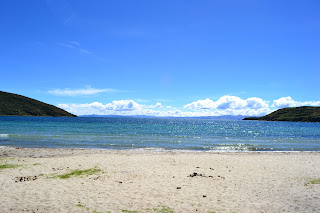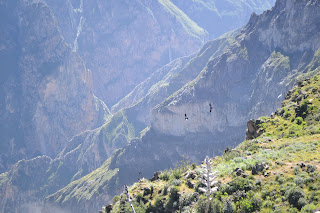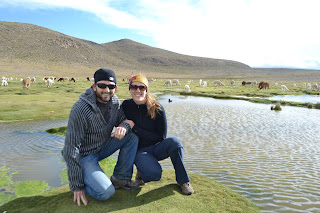Whew. What a fun and active last few days we have had! We’ve
explored the winding streets of La Paz, avoided Bolivian protests, been to an
amazing football game, survived the death road and are now in a secluded jungle
hostel in the Yungas relaxing and catching our breath.
Late on Monday night we arrived in La Paz, and went straight
to a hotel that Tim had found in our travel book. It was at the high end of our
budget for accommodation ($15 US per person per night) at a whopping $180
Bolivianos a night and it was SO worth the investment. We had a real hot shower
rather than an electric heated one! Let me pause to explain the trials of the
electric shower: most showers in South America are heated by small electric
boxes attached to the top of the shower head. If you turn the water pressure on
too high it won’t be able to heat all the water so most showers must be
trickles with barley any pressure at all if you want them warm. Also, if you
happen to touch anything metal, like an ungrounded shower knob or head you will
get shocked. We learned this the hard way. Electric showers are more like
playing Russian roulette than having a relaxing, cleaning experience. Anyway, I digress, our hotel in La Paz had a
real hot shower and a nice warm, soft bed and we slept like kings and didn’t
mind that we weren’t saving money. And no matter, since we were still under our
accommodation budget of $30/night. It is so cheap to travel in Bolivia! We love
it!
We spent Tuesday and Wednesday wandering the streets of La
Paz, which is anything but peaceful, as its name in Spanish suggests. We had
been warned by our taxi driver that there would be protests while we were there
and indeed, protests were one of the first sights (and sounds!) that greeted us
when we walked down to the nearest plaza on Tuesday morning. There were,
seemingly, thousands of angry Bolivian teachers, nurses, students and other
government workers marching in the streets with banners, loudspeakers and
costumes. Police, with riot shields, closed off the roads and stood around,
unfazed by the blasts of handheld sticks of dynamite detonated by the
protesters. This seemed so wild to me and Tim, but I guess it is business as
usual in Bolivia. All was safe and legal. How strange!

We mostly avoided the protests (Thanks to Simeon, our PC
Safety and Security officer, who instilled in us the ever-present desire to
avoid “red zones”!) and instead went to the Coca Museum and learned about the
history, mythical legends and legality of the controversial Coca plant. We were
impressed to learn that the Incas used coca as an anesthetic for brain surgery
well before European doctors figured out that it would be better to numb the
patient rather than just hit them over the head before operation. We ate good
food in cafés and restaurants (avoiding street food, sadly, upon the
recommendations of practically everyone we talked to) and bought souvenirs
while meandering the confusingly twisty, turning, and hilly streets.
On Wednesday as we walked past a pub, we saw an
advertisement for a live football game later that night; Bolivar vs. Santos
quarterfinal match in La Paz! I immediately got SO excited. When I lived in
Mexico, one of my favorite things to do was watch our local team, the Monarcas,
play at the local stadium! This match was going to be good one too, I knew,
since it was the local Bolivian team versus a Brazilian team trying to get into
the top four in the Santander South American champion’s tournament. So without
much thought, we jumped in a taxi, sped off to the stadium, bought excellent
tickets right in front of center field, grabbed a quick bite to eat and some
fan gear (Bolivar scarves to show our support to the home team) and were swept
up in the excitement of a real South American football game! I knew a lot of
the cheers from my time in Mexico, we just had to change the team name, so Tim
and I sang and cheered and cursed with the rest of stadium. It was a great
game, with the home team scoring a goooooolllllllll! within the first 2
minutes, then Santos tying the game in the first half and Bolivar getting a
game winning goal in the second half. The stadium went wild with confetti,
fireworks, dynamite, cheers, songs and dancing. It was exhilarating!


We kept the adrenaline high going the next day too, as we
had planned a tour with the most reputable mountain bike company to ride down
the “Death Road” from La Paz to the Bolivian jungle. The road is about 3,500
meters (about 2.25 miles) of pure downhill. It used to be the only road from La
Paz to the jungle, and was built by hundreds of POWs from Paraguay (many of
whom died in the making, which is how the road got its name). In parts, the
road is narrow and has a sheer drop off to the jungle floor below. Nowadays
cars use a new bypass and the road is mostly used by tourists seeking the
thrill of biking downhill on this beautiful, scary, fun road. We woke early for
the tour to get fitted with safety equipment (full face helmet, long pants,
gloves and a bright orange safety vest for visibility) and test out our full
suspension mountain bikes. After a safety briefing we proceeded, led by our two
experienced guides, down the road.
Our ride was comprised of two parts. The first was the paved
road that started in the cold mountains outside La Paz, where we sped down with
ease at about 50km/hour or so. As we zoomed down it got warmer and we came to
the second part of the ride, where the road turned to gravel, the mountains
turned into jungle and the sheer drop off to the jungle floor was at our side.
Here we slowed down (a bit) and took more care around the turns. We knew our
limits and didn’t push ourselves to do anything stupid, neither of us wanted to
end up careening off the cliff. Needless to say it was a thrill. We stopped at
points for photo ops (our guides took all the pictures, and would often ride
ahead to take photos of us riding, we should be getting that DVD when we get
back to La Paz tomorrow) and snacks. The scenery was stunning but we mostly
focused on the road while we were riding, because we are sensible like that.
When we finally reached the bottom, we were pumped up on adrenaline and pride!
The tour ended with a buffet lunch, some beers and a dip in a swimming pool! It
was a super fun day!
 |
| You can see the "Death Road" behind me! |
 |
| The Sock Monkeys survived the Death Road too! |
Tim and I had decided ahead of time to stay in Coroico, a
town near the bottom of the valley where our tour ended. That’s where we are
now, in a hostel like no other, called Sol y Luna, which had been recommended
by our Irish friend Catherine. This place is about 15-minute drive outside the
sleepy, jungle town of Coroico, and is more of a nature retreat than a hostel.
There are two different swimming pools, a hot tub available, a meditation room,
plenty of walking paths and hammocks strung under cabanas, private cabins and a
dorm, and a restaurant with lovely friendly staff. Yesterday when we arrived it
was sunny and warm and reminded us of Guyana. We took a nap in a hammock and
read, enjoying the stunning views of the valley and taking a well-deserved rest
after the ride. Friday, however, it was raining and overcast so we weren’t able
to enjoy the views or walk the grounds and swim in the pools as we had planned.
We didn’t mind though, we were content reading in our cozy room, listening to
the rain fall, watching the lemon trees and flowers shiver under the raindrops
outside our window and occasionally popping over to the restaurant for fresh
yogurt, coffee, tea and other deliciousness.
 |
| Our lovely hostel retreat |
 |
| Overlooking the valleys of the Yungas |
On Saturday, we decided to stay in Coroico for a day longer
since, when we woke up, the weather was beautiful and we didn’t get a chance to
explore the day before. We took
advantage of the sunshine and washed a
load of our stinky traveler laundry washed and hung it out to dry (only a few
more hand-washing loads of laundry and we will be back in the land’o washing
machines, hooray!). Then we headed out with a map of the surrounding hillsides
to find three nearby waterfalls. Our hike was stunning. The hills overlooked
the coca fields and small in the valley below, multicolored butterflies
fluttered all around. It was apparent that not a lot of travelers go on the
trails we hiked because, in parts, the trail was so over grown that we had to
push our way through shoulder high grass, vines and flowers and jump over
streams that covered the entire path. We felt like true jungle explorers. The
waterfalls were nice but the beauty of hike itself was our reward.
 |
| Waterfalls and good company makes for a good hike! |
 |
| Waterfall fun |
 |
| Monkeys in the Yungas |
We ended our day trek in Coroico with a tasty snack of
saltenas (sweet and savory empanada like pies full of chicken, potato, eggs and
other goodness) and homemade ice cream. Then we headed back to our oasis hostel
for a dip in the pool to cool off. We were so happy that the weather was warm
and we could enjoy the Yungas. Tomorrow we are off to La Paz where we will post pictures on
this blog in an internet café, Tim might get a haircut in the barbershop and
then we will take a night bus to Uyuni to see the famous, largest salt flats in
the world! Life is good and we are happy!
 |
| Adorable Bolivian kiddos and moms in traditional dress chill in the Plaza |
 |
| Beautiful, traditionally dressed Afro-Bolivian ladies in the Coroico plaza |



















































